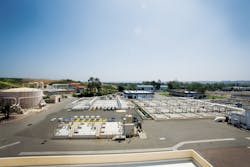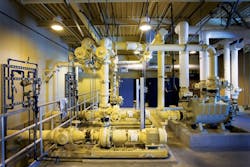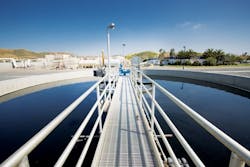About the author:
Lauren Baltas is associate editor for W&WD. Baltas can be reached at [email protected] or 847.391.1019.
- Name: San Luis Rey Wastewater Treatment Plant
- Location: Oceanside, Calif.
- Size: 13.5 mgd
- Infrastructure: Headworks, centrifugal grit removal, rag washing and degritting, load equalization
While the San Luis Rey Wastewater Treatment Plant (WWTP) may not sing, dance or act, its trio of skills is coveted in the wastewater industry. Located in Oceanside, Calif., the WWTP had to adapt to the state’s drought. In response, the facility has enhanced its sustainability features, adding water recycling, indirect potable reuse (IPR) and a biosolids master plan.
In With the Old
Built in 1975 by the city of Oceanside, the conventional activated sludge plant serves a 43-sq-mile area, which includes the growing population of Oceanside, as well as 10,000 residents from Rainbow, Calif., and 5,000 from Vista, Calif. The semi-arid area imports 87% of its water, only drafting 13% of its supply from the local groundwater basin, which is under stress due to the drought.
The facility includes two separate plants, referred to as Plant One and Plant Two. Before the drought, the WWTP required extra capacity to meet the needs of the growing population and installed Plant Two in 2004. When the drought caused flows to drop by approximately 20%, the facility took Plant Two offline. Plant One’s treatment processes have adapted to lower flows, treating an average of 9.3 million gal per day (mgd) with a maximum of 13.5 mgd.
“I think [the wastewater flow] is going to plateau and stay like it is at this point,” said Scott Speigle, chief plant operator – sewer for the city of Oceanside Water Utilities Department. “People trained themselves in the past three to five years, and they’re conserving. So we’re staying with just a little bit higher-strength wastewater coming in due to that.”
Treatment begins at the city’s 34 lift stations, where bioxide or ferric chloride is added to treat odors. At the facility, operators inject 52% hydrogen peroxide to oxidize additional odors. Wastewater travels by three main pump lines with flowmeters into headworks, centrifugal grit removal, and rag washing and degritting. It then travels to load equalization tanks so operators can control levels over a 24-hour period. Treatment takes approximately six hours with liquid flow, and solids are kept on site for 20 to 30 days.
The WWTP adapted to lower flows due to the drought.
No Water, No Problem
Because Oceanside and its surrounding communities rely heavily on imported water supplies, the WWTP is developing new water resources. This development is twofold—water recycling for irrigation and agriculture, and IPR, or groundwater augmentation, for drinking water.
The first step is to decommission an existing plant, the La Salina WWTP. Because of the value of its coastal property and the associated maintenance costs, the plant is no longer financially prudent. Its flows will be directed to the San Luis Rey WWTP.
A design-build project will accommodate the new water recycling features. The project includes construction of a new plant, as well as expansion of Plant One, producing 4.4 mgd of feedwater for recycling, with a maximum capacity of 6.8 mgd.
The project is projected to produce an additional 6 mgd of feedwater for IPR. The added level of treatment will include microfiltration with ultraviolet light and advanced oxidation, as well as reverse osmosis. To inject the water into the groundwater basin, 3 mgd will be pumped into the ground and 3 mgd will be spread to percolate the ground.
Although the facility had to take Plant Two offline shortly after its construction, the plant will prove useful within the next 5 to 10 years. After the new projects are complete, Plant One will produce feedwater for recycling and Plant Two will produce feedwater for IPR. In addition, the new design-build plant will help produce recycled water. Together, these processes will use the majority—approximately 75%—of the wastewater it processes for other, more sustainable purposes.
Good Gases
The WWTP also is implementing a new biosolids master plan. While it is still in the planning stages, this plan proposes to construct a pilot plant that takes organic waste, slightly processes it and inserts it into the wastewater treatment plant. This waste normally would be directed to a landfill.
Treating the solid waste will increase gas production, creating 1 MW of electrical power, which will heat the digesters. In addition, this new process will decrease the amount of methane gas produced at the landfill, as the facility can capture the gas and prevent it from harming the atmosphere. This plan will limit the amount of solid waste entering the landfill and the harmful gases the landfill produces.
New reuse processes will repurpose approximately 75% of the facility’s wastewater.


